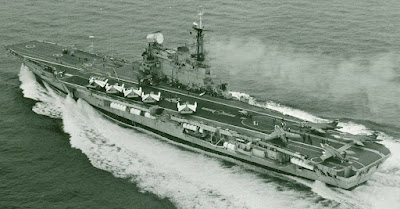One of the 1:1200th-scale model ships that I recently acquired was of HMS Bulwark, …
The Minic Ships 1:1200th-scale model of HMS Bulwark.
… which was one of the four Centaur-class Light Fleet Aircraft Carriers that were ordered in 1943 and completed and commissioned between 1953 and 1959.
HMS Centaur as completed.
It was originally intended to be a class of eight ships, but four (HMS Arrogant, HMS Hermes (1), HMS Monmouth, and HMS Polyphemus) were cancelled before they were laid down. The ships that were eventually completed were:
- HMS Centaur
- HMS Albion
- HMS Bulwark
- HMS Hermes (originally named HMS Elephant)
The design was simplified as much as possible and were built to a hybrid naval and merchantile standard with limited armoured protection, half of the propulsion machinery that had been designed for the larger Audacious-class aircraft carriers, and an armament of light anti-aircraft guns. (It had originally intended to arm them with four twin 4.5-inch dual-purpose, between-deck guns but these were removed from the design before they were built.)
They were originally going to be equipped with a single hydraulic catapult and an axial deck, but in 1947 the design was modified to include a second catapult and a partial angle flight deck. The first three were completed to this design, but only HMS Centaur was later modernised with steam catapults as HMS Albion and HMS Bulwark were converted into helicopter assault ships or Commando carriers.
- HMS Centaur was decommissioned in 1965 and used as an accommodation ship until she was scrapped in 1972.
- HMS Albion remained in service until 1973 and was scrapped soon after she was decommissioned.
- HMS Bulwark went into reserve in 1976 but was recommissioned in 1979 after a two-year refit. She suffered a couple of fires which reduced her maximum speed, and she was finally withdrawn from service in 1981. She was scrapped in 1984.
HMS Hermes was completed to a much-modified design. She had two steam catapults, a full 8-degree angle flight deck, a side lift instead of a more normal forward centerline lift, the Comprehensive Display System (CDS) command, control, and coordination system, and the Type 984 radar. The latter featured a large fully stabilised, lantern-like structure that was mounted above the bridge.
HMS Hermes as completed. The Type 984 radar gave the ship an almost unique silhouette as only other ships equipped with it were HMS Victorious and HMS Eagle.
She operated as a fleet carrier from 1959 until 1971 when she was refitted as a helicopter assault ship. The CDS and type 984 radar were removed, as were the steam catapults and arrester gear. In 1980 she was again taken in hand and modified so that she could operate Sea Harriers as well as helicopters. The alterations also included the addition of a 12-degree ski-jump. She returned to service in 1981 and served as the flagship of the Falklands Task Force.
HMS Hermes was sold to India in the mid 1980s and was refitted before she was commissioned as INS Viraat in 1987. She served until 2017 and was sold for scrapping in 2020.
HMS Viraat.



























.jpeg)










Nice acquisition Bob!
ReplyDeleteGeordie an Exiled FoG,
DeleteIt’s a very nice model … and better than my older version of the model.
All the best,
Bob